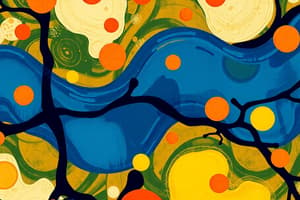Podcast
Questions and Answers
What is produced for each turn of beta oxidation?
What is produced for each turn of beta oxidation?
- 2 FADH2 and 2 NADH
- 2 Acetyl-CoA and 1 NADH
- 1 Acetyl-CoA only
- 1 NADH and 1 FADH2 (correct)
The oxidation of palmitic acid (16:0) yields 8 Acetyl-CoA molecules.
The oxidation of palmitic acid (16:0) yields 8 Acetyl-CoA molecules.
True (A)
How many ATP are yielded from the complete oxidation of one mole of palmitic acid?
How many ATP are yielded from the complete oxidation of one mole of palmitic acid?
129
The oxidation of margaric acid (17:0) produces 7 Acetyl CoA and 1 ________ CoA.
The oxidation of margaric acid (17:0) produces 7 Acetyl CoA and 1 ________ CoA.
Match the following stages of fatty acid synthesis with their appropriate descriptions:
Match the following stages of fatty acid synthesis with their appropriate descriptions:
Which of the following is NOT a role of lipids?
Which of the following is NOT a role of lipids?
Lipids are soluble in water.
Lipids are soluble in water.
Name a type of lipid that plays a role in signaling.
Name a type of lipid that plays a role in signaling.
Triacylglycerol is primarily used for _______ storage in adipose tissue.
Triacylglycerol is primarily used for _______ storage in adipose tissue.
Match the following types of lipids with their descriptions:
Match the following types of lipids with their descriptions:
Which fatty acid structure is represented as having a carboxylic acid functional group?
Which fatty acid structure is represented as having a carboxylic acid functional group?
Sphingolipids are a type of glycerophospholipid.
Sphingolipids are a type of glycerophospholipid.
What are the main components of triacylglycerol?
What are the main components of triacylglycerol?
What is the primary structure that lipoproteins help with in the body?
What is the primary structure that lipoproteins help with in the body?
Cholesteryl esters are digested into free cholesterol and monoacylglycerol.
Cholesteryl esters are digested into free cholesterol and monoacylglycerol.
What are the fat-soluble vitamins that are absorbed during lipid digestion?
What are the fat-soluble vitamins that are absorbed during lipid digestion?
The main product of fatty acid oxidation with an even number of carbons is ___.
The main product of fatty acid oxidation with an even number of carbons is ___.
Match the types of lipoproteins with their primary characteristics:
Match the types of lipoproteins with their primary characteristics:
What role do bile salts play in lipid digestion?
What role do bile salts play in lipid digestion?
Sphingomyelins are a type of glycolipid.
Sphingomyelins are a type of glycolipid.
What is the enzyme involved in the initial digestion of lipids in the mouth?
What is the enzyme involved in the initial digestion of lipids in the mouth?
Flashcards
Lipids
Lipids
Organic molecules that are insoluble in water but readily soluble in organic solvents.
Fatty Acid
Fatty Acid
A compound with a long hydrocarbon chain and a carboxylic acid group at one end.
Glycerol
Glycerol
A three-carbon alcohol that forms the backbone of many lipids, including triglycerides.
Triacylglycerol (Triglyceride)
Triacylglycerol (Triglyceride)
Signup and view all the flashcards
Phospholipid
Phospholipid
Signup and view all the flashcards
Wax
Wax
Signup and view all the flashcards
Eicosanoids
Eicosanoids
Signup and view all the flashcards
Steroid
Steroid
Signup and view all the flashcards
β-oxidation
β-oxidation
Signup and view all the flashcards
Beta Oxidation Cycle
Beta Oxidation Cycle
Signup and view all the flashcards
Propionyl CoA
Propionyl CoA
Signup and view all the flashcards
Fatty Acid Synthesis
Fatty Acid Synthesis
Signup and view all the flashcards
Acetyl CoA Transport
Acetyl CoA Transport
Signup and view all the flashcards
Sphingolipid
Sphingolipid
Signup and view all the flashcards
Glycolipids
Glycolipids
Signup and view all the flashcards
Estradiol
Estradiol
Signup and view all the flashcards
Testosterone
Testosterone
Signup and view all the flashcards
Lipid Digestion
Lipid Digestion
Signup and view all the flashcards
Micelles
Micelles
Signup and view all the flashcards
Lipoproteins
Lipoproteins
Signup and view all the flashcards
Study Notes
Lipids
- Lipids are water-insoluble (hydrophobic) molecules that are highly soluble in organic solvents.
- They have both hydrophilic (water-loving) and hydrophobic (water-fearing) regions.
- Lipids play crucial roles in energy storage, membrane structure, and signaling.
Learning Objectives
- Explain the structural properties of lipids
- Explain the roles of lipids
- Classify lipids
- Recognize fatty acids
- Explain lipid digestion and absorption
- Recognize steroids
- Classify lipoproteins
- Explain fatty acid catabolism (beta oxidation)
- Explain fatty acid synthesis
Types of Lipids
- Fatty acids
- Waxes
- Sphingolipids
- Phospholipids
- Steroids
- Triacylglycerides
- Terpenes
- Ceramides
- Eicosanoids
- Others (implied)
Roles of Lipids
- Used for energy storage (needs less water than carbohydrates)
- Key components of cell membranes
- Crucial elements in signaling pathways (hormones)
- Thermal insulation
Fatty Acids
- Simplest form of lipids
- Long hydrocarbon chain with a carboxyl group at one end
- Saturated (no double bonds) vs. unsaturated (one or more double bonds)
- Saturated fats are generally solid at room temperature, while unsaturated fats are liquid.
- Unsaturated fats can be further categorized as cis or trans, based on the spatial arrangement of their double bonds.
Triacylglycerols (TAGs)
- Storage lipids
- Formed from glycerol and three fatty acids
- Essential for energy storage in adipose tissue
Phospholipids
- Major components of cell membranes.
- Composed of glycerol, two fatty acids and phosphate group.
- The structure includes hydrophobic and hydrophilic regions, which makes them suitable for cell membranes.
- Glycerophospholipids (phosphoglycerides) and sphingophospholipids are two important types.
Glycolipids
- Lipids with carbohydrate groups attached.
- Crucial for cell recognition and signaling.
- Ceramide (glycosphingolipid) backbone is common for many glycolipids.
- Blood type antigens are glycolipids.
Steroids
- Hormones (estradiol, testosterone)
- Lipid digestion (bile acids)
- Component of cell membranes (cholesterol)
Lipid Digestion
- Breakdown of dietary lipids into smaller components.
- Crucial enzymes include lingual lipase (mouth), gastric lipase (stomach), pancreatic lipase (intestine)
- Bile salts play a critical role in emulsifying lipids for easier digestion.
Lipid Absorption
- Absorption of lipid components from the small intestine.
- Free fatty acids, 2-monoacylglycerol, glycerol and cholesterol are absorbed directly into the intestinal cells.
- Fat-soluble vitamins (A, D, E and K) are absorbed along with lipids.
- Bile salts are mostly excreted by the body, partially absorbed from small intestines.
Lipid Transport
- Lipids must be transported in the blood because they are not water soluble.
- Lipoproteins are assemblies of lipid molecules surrounded by proteins which transport lipids throughout the body.
- Chylomicrons, VLDL, LDL, and HDL are different types of lipoproteins responsible for delivering absorbed lipids to the rest of the body.
Lipid Catabolism (Fatty Acid Oxidation)
- Breakdown of fatty acids to produce energy
- The process of fatty acid oxidation occurs in the mitochondria.
- Fatty acids enter the mitochondria with the help of carnitine.
- β-oxidation process removes 2 carbon units as acetyl-CoA.
Fatty Acid Synthesis
- Synthesis of fatty acids from acetyl CoA.
- This occurs in the cytosol.
- The process involves the use of acetyl CoA and NADPH as starting materials.
- Three main stages: Acetyl CoA transport to the cytoplasm, Malonyl CoA synthesis, and Elongation of fatty acid chain.
- The synthesis of longer fatty acids (essential fatty acids) requires desaturation and elongation stages.
Studying That Suits You
Use AI to generate personalized quizzes and flashcards to suit your learning preferences.




